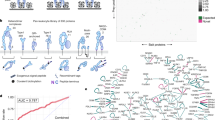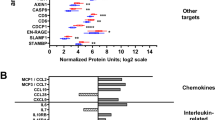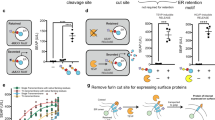Abstract
Synthetic circuits that regulate protein secretion in human cells could support cell-based therapies by enabling control over local environments. Although protein-level circuits enable such potential clinical applications, featuring orthogonality and compactness, their non-human origin poses a potential immunogenic risk. In this study, we developed Humanized Drug Induced Regulation of Engineered CyTokines (hDIRECT) as a platform to control cytokine activity exclusively using human-derived proteins. We sourced a specific human protease and its FDA-approved inhibitor. We engineered cytokines (IL-2, IL-6 and IL-10) whose activities can be activated and abrogated by proteolytic cleavage. We used species specificity and re-localization strategies to orthogonalize the cytokines and protease from the human context that they would be deployed in. hDIRECT should enable local cytokine activation to support a variety of cell-based therapies, such as muscle regeneration and cancer immunotherapy. Our work offers a proof of concept for the emerging appreciation of humanization in synthetic biology for human health.

This is a preview of subscription content, access via your institution
Access options
Access Nature and 54 other Nature Portfolio journals
Get Nature+, our best-value online-access subscription
27,99 € / 30 days
cancel any time
Subscribe to this journal
Receive 12 print issues and online access
269,00 € per year
only 22,42 € per issue
Buy this article
- Purchase on SpringerLink
- Instant access to full article PDF
Prices may be subject to local taxes which are calculated during checkout






Similar content being viewed by others
Data availability
Raw experimental data and computation-generated data for main text figures are provided as Source Data. Raw flow cytometry data (.fcs files) for Fig. 6 and Extended Data Fig. 1 are available from the corresponding author upon reasonable request. Raw experimental data for supplementary figures are included in Supplementary Data 1. New plasmids used in this study are available for distribution from Addgene (https://www.addgene.org/Xiaojing_Gao/), and a comprehensive list of plasmids used in this study can be found in Supplementary Table 1 (including their Addgene IDs). Protein sequences were retrieved from UniProt (https://www.uniprot.org/) to align renin and its substrates (P11859, P01019, P00797 and P06281). Crystal structures of renin complexed with its susbtrate were obtained from the RCSB Protein Data Bank (https://www.rcsb.org/) (6I3F). The protein sequence of HCVp (genotype 1a, NS3) was obtained from GenBank (https://www.ncbi.nlm.nih.gov/genbank/) (NC_004102). Source data are provided with this paper.
References
Fischbach, M. A., Bluestone, J. A. & Lim, W. A. Cell-based therapeutics: the next pillar of medicine. Sci. Transl. Med. 5, 179ps7 (2013).
Labanieh, L., Majzner, R. G. & Mackall, C. L. Programming CAR-T cells to kill cancer. Nat. Biomed. Eng. 2, 377–391 (2018).
Ninagawa, N. T. et al. Transplantated mesenchymal stem cells derived from embryonic stem cells promote muscle regeneration and accelerate functional recovery of injured skeletal muscle. Biores. Open Access 2, 295–306 (2013).
Winkler, T. et al. Dose–response relationship of mesenchymal stem cell transplantation and functional regeneration after severe skeletal muscle injury in rats. Tissue Eng. Part A 15, 487–492 (2009).
Munir, H. & McGettrick, H. M. Mesenchymal stem cell therapy for autoimmune disease: risks and rewards. Stem Cells Dev. 24, 2091–2100 (2015).
Squillaro, T., Peluso, G. & Galderisi, U. Clinical trials with mesenchymal stem cells: an update. Cell Transplant. 25, 829–848 (2016).
Marofi, F. et al. CAR T cells in solid tumors: challenges and opportunities. Stem Cell Res. Ther. 12, 81 (2021).
Preda, M. B. et al. Short lifespan of syngeneic transplanted MSC is a consequence of in vivo apoptosis and immune cell recruitment in mice. Cell Death Dis. 12, 566 (2021).
Kim, N. & Cho, S.-G. New strategies for overcoming limitations of mesenchymal stem cell-based immune modulation. Int. J. Stem Cells 8, 54–68 (2015).
Kerkar, S. P. et al. Tumor-specific CD8+ T cells expressing interleukin-12 eradicate established cancers in lymphodepleted hosts. Cancer Res. 70, 6725–6734 (2010).
Nitahara-Kasahara, Y. et al. Enhanced cell survival and therapeutic benefits of IL-10-expressing multipotent mesenchymal stromal cells for muscular dystrophy. Stem Cell Res. Ther. 12, 105 (2021).
Chen, Z. & Elowitz, M. B. Programmable protein circuit design. Cell 184, 2284–2301 (2021).
Gao, X. J., Chong, L. S., Kim, M. S. & Elowitz, M. B. Programmable protein circuits in living cells. Science 361, 1252–1258 (2018).
Fink, T. et al. Design of fast proteolysis-based signaling and logic circuits in mammalian cells. Nat. Chem. Biol. 15, 115–122 (2019).
Tague, E. P., Dotson, H. L., Tunney, S. N., Sloas, D. C. & Ngo, J. T. Chemogenetic control of gene expression and cell signaling with antiviral drugs. Nat. Methods 15, 519–522 (2018).
Jacobs, C. L., Badiee, R. K. & Lin, M. Z. StaPLs: versatile genetically encoded modules for engineering drug-inducible proteins. Nat. Methods 15, 523–526 (2018).
Sahin, U., Karikó, K. & Türeci, Ö. mRNA-based therapeutics—developing a new class of drugs. Nat. Rev. Drug Discov. 13, 759–780 (2014).
Vlahos, A. E. et al. Protease-controlled secretion and display of intercellular signals. Nat. Commun. 13, 912 (2022).
Praznik, A. et al. Regulation of protein secretion through chemical regulation of endoplasmic reticulum retention signal cleavage. Nat. Commun. 13, 1323 (2022).
Ferdosi, S. R. et al. Multifunctional CRISPR–Cas9 with engineered immunosilenced human T cell epitopes. Nat. Commun. 10, 1842 (2019).
Lamers, C. H. J. et al. Immune responses to transgene and retroviral vector in patients treated with ex vivo-engineered T cells. Blood 117, 72–82 (2011).
Riechmann, L., Clark, M., Waldmann, H. & Winter, G. Reshaping human antibodies for therapy. Nature 332, 323–327 (1988).
Jones, P. T., Dear, P. H., Foote, J., Neuberger, M. S. & Winter, G. Replacing the complementarity-determining regions in a human antibody with those from a mouse. Nature 321, 522–525 (1986).
Li, H.-S. et al. Multidimensional control of therapeutic human cell function with synthetic gene circuits. Science 378, 1227–1234 (2022).
Rauch, S. et al. Programmable RNA-guided RNA effector proteins built from human parts. Cell 178, 122–134 (2019).
Zhu, I. et al. Modular design of synthetic receptors for programmed gene regulation in cell therapies. Cell 185, 1431–1443.e16 (2022).
Danser, A. H. J. & Deinum, J. Renin, prorenin and the putative (pro)renin receptor. Hypertension 46, 1069–1076 (2005).
Vaidyanathan, S., Jarugula, V., Dieterich, H. A., Howard, D. & Dole, W. P. Clinical pharmacokinetics and pharmacodynamics of aliskiren. Clin. Pharmacokinet. 47, 515–531 (2008).
Puskas, J. et al. Development of an attenuated interleukin-2 fusion protein that can be activated by tumour-expressed proteases. Immunology 133, 206–220 (2011).
Hsu, E. J. et al. A cytokine receptor-masked IL2 prodrug selectively activates tumor-infiltrating lymphocytes for potent antitumor therapy. Nat. Commun. 12, 2768 (2021).
Wang, X., Wong, K., Ouyang, W. & Rutz, S. Targeting IL-10 family cytokines for the treatment of human diseases. Cold Spring Harb. Perspect. Biol. 11, a028548 (2019).
Sarvas, J. L., Khaper, N. & Lees, S. J. The IL-6 paradox: context dependent interplay of SOCS3 and AMPK. J. Diabetes Metab. https://doi.org/10.4172/2155-6156.s13-003 (2013).
Serrano, A. L., Baeza-Raja, B., Perdiguero, E., Jardí, M. & Muñoz-Cánoves, P. Interleukin-6 is an essential regulator of satellite cell-mediated skeletal muscle hypertrophy. Cell Metab. 7, 33–44 (2008).
Zhang, C. et al. Interleukin-6/signal transducer and activator of transcription 3 (STAT3) pathway is essential for macrophage infiltration and myoblast proliferation during muscle regeneration. J. Biol. Chem. 288, 1489–1499 (2013).
Liao, W., Lin, J.-X. & Leonard, W. J. Interleukin-2 at the crossroads of effector responses, tolerance, and immunotherapy. Immunity 38, 13–25 (2013).
Rosenberg, S. A. Interleukin 2 for patients with renal cancer. Nat. Clin. Pract. Oncol. 4, 497 (2007).
Hawkins, E. R., D’Souza, R. R. & Klampatsa, A. Armored CAR T-cells: the next chapter in T-cell cancer immunotherapy. Biologics 15, 95–105 (2021).
Logsdon, N. J., Jones, B. C., Josephson, K., Cook, J. & Walter, M. R. Comparison of interleukin-22 and interleukin-10 soluble receptor complexes. J. Interferon Cytokine Res. 22, 1099–1112 (2002).
Gorby, C. et al. Engineered IL-10 variants elicit potent immunomodulatory effects at low ligand doses. Sci. Signal. 13, eabc0653 (2020).
Garbers, C. et al. Plasticity and cross-talk of interleukin 6-type cytokines. Cytokine Growth Factor Rev. 23, 85–97 (2012).
Wolf, J., Rose-John, S. & Garbers, C. Interleukin-6 and its receptors: a highly regulated and dynamic system. Cytokine 70, 11–20 (2014).
Kwon, B. The two faces of IL-2: a key driver of CD8+ T-cell exhaustion. Cell. Mol. Immunol. 18, 1641–1643 (2021).
Shikano, S. & Li, M. Membrane receptor trafficking: evidence of proximal and distal zones conferred by two independent endoplasmic reticulum localization signals. Proc. Natl Acad. Sci. USA 100, 5783–5788 (2003).
Fukamizu, A. et al. Dependence of angiotensin production in transgenic mice carrying either the human renin or human angiotensinogen genes on species-specific kinetics of the renin-angiotensin system. Arzneimittelforschung 43, 222–225 (1993).
Wu, Z., Yang, H. & Colosi, P. Effect of genome size on AAV vector packaging. Mol. Ther. 18, 80–86 (2010).
Kalidasan, V. et al. A guide in lentiviral vector production for hard-to-transfect cells, using cardiac-derived c-kit expressing cells as a model system. Sci. Rep. 11, 19265 (2021).
Tang, W. et al. Faithful expression of multiple proteins via 2A-peptide self-processing: a versatile and reliable method for manipulating brain circuits. J. Neurosci. 29, 8621–8629 (2009).
Subramanian, N., Torabi-Parizi, P., Gottschalk, R. A., Germain, R. N. & Dutta, B. Network representations of immune system complexity. Wiley Interdiscip. Rev. Syst. Biol. Med. 7, 13–38 (2015).
Orzechowski, A. Cytokines in skeletal muscle growth and decay. In The Plasticity of Skeletal Muscle (ed Sakuma, K.) 113–139 (Springer Singapore, 2017).
Yang, W. & Hu, P. Skeletal muscle regeneration is modulated by inflammation. J. Orthop. Transl. 13, 25–32 (2018).
Steyn, P. J., Dzobo, K., Smith, R. I. & Myburgh, K. H. Interleukin-6 induces myogenic differentiation via JAK2-STAT3 signaling in mouse C2C12 myoblast cell line and primary human myoblasts. Int. J. Mol. Sci. 20, 5273 (2019).
Deng, B., Wehling-Henricks, M., Villalta, S. A., Wang, Y. & Tidball, J. G. IL-10 triggers changes in macrophage phenotype that promote muscle growth and regeneration. J. Immunol. 189, 3669–3680 (2012).
Coppola, C. et al. Investigation of the impact from IL-2, IL-7, and IL-15 on the growth and signaling of activated CD4+ T cells. Int. J. Mol. Sci. 21, 7814 (2020).
Nielsen, M. & Andreatta, M. NetMHCpan-3.0; improved prediction of binding to MHC class I molecules integrating information from multiple receptor and peptide length datasets. Genome Med. 8, 33 (2016).
Calis, J. J. A. et al. Properties of MHC class I presented peptides that enhance immunogenicity. PLoS Comput. Biol. 9, e1003266 (2013).
Vaidyanathan, S. et al. Pharmacokinetics, safety, and tolerability of the novel oral direct renin inhibitor aliskiren in elderly healthy subjects. J. Clin. Pharmacol. 47, 453–460 (2007).
Gradman, A. H. et al. Aliskiren, a novel orally effective renin inhibitor, provides dose-dependent antihypertensive efficacy and placebo-like tolerability in hypertensive patients. Circulation 111, 1012–1018 (2005).
Kishina, M. et al. Therapeutic effects of the direct renin inhibitor, aliskiren, on non-alcoholic steatohepatitis in fatty liver Shionogi ob/ob male mice. Hepatol. Res. 44, 888–896 (2014).
Acknowledgements
This research was supported by the National Institutes of Health (NIH) (R00EB027723 and DP2OD034951; X.J.G.); Longevity Impetus grants (X.J.G.); a Wu Tsai Human Performance Alliance Agility Project Grant (X.J.G.); the Stanford Bio-X Interdisciplinary Initiatives Seed Grant Program (R11-7; X.J.G.); a Stanford Graduate Fellowship (C.A.A.); the Sarafan ChEM-H CBI training program (C.A.A.); the Bio-X Stanford Interdisciplinary Graduate Fellowship (C.A.A.); an NIH Cellular and Molecular Biology training grant (T32 GM007276; C.C.C.); a National Science Foundation Graduate Research Fellowship (DGE-2146755; C.C.C. and L.E.S.); the International Human Frontier Science Program Organization (LT000221/2021-L; A.E.V.); a Welch Foundation grant (I-2095-20220331; Q.C.); and support as a Southwestern Medical Foundation endowed scholar (Q.C.).
Author information
Authors and Affiliations
Contributions
C.A.A. and X.J.G. conceived and directed the study. C.A.A. designed and performed all experiments for the protein engineering and characterization. C.C.C. designed and performed the T cell proliferation and in vivo study. A.E.V. created the transmembrane ___domain and ER retention motifs for renin constructs as well as performed tail vein injections for the in vivo study. J.P. and Q.C. provided recommended mutations for the H2M renin. L.E.S. conducted the computational immunogenicity analysis. C.A.A. and C.C.C. analyzed the data for the manuscript. C.A.A., X.J.G. and C.C.C. wrote the manuscript. All authors provided feedback on the manuscript.
Corresponding author
Ethics declarations
Competing interests
The Board of Trustees of Stanford University has filed a patent on behalf of the inventors (C.A.A. and X.J.G.) of the small-molecule control of membrane and secreted proteins using human proteases platform described (US provisional application no. 63/458833). An additional provisional patent application has also been filed on behalf of the inventors (C.A.A., X.J.G., J.P. and Q.C.) for the orthogonalization of human renin. X.J.G. is a co-founder and serves on the scientific advisory board of Radar Tx. The remaining authors declare no competing interests.
Peer review
Peer review information
Nature Chemical Biology thanks John Ngo and the other, anonymous reviewer(s) for their contribution to the peer review of this work.
Additional information
Publisher’s note Springer Nature remains neutral with regard to jurisdictional claims in published maps and institutional affiliations.
Extended data
Extended Data Fig. 1 Gating Strategy for FACS and flow cytometry analysis of K562s and T cell expansion.
a, Gating strategy used to sort K562s engineered to express IL-2 hDIRECT (mCherry+) from lentiviral transduced population used in the T cell expansion assay on Fig. 6b-c. b, Gating strategy to analyze T cell expansion with co-incubation with hDIRECT-engineered K562s (mCherry+). Cells and singlets were liberally gated to include all possible cells and to identify T cells (mCherry-) for analysis in Fig. 6b.
Supplementary information
Supplementary Information
Supplementary Figs. 1–14 and Supplementary Tables 1–3.
Supplementary Data 1
Source data for supplementary figures.
Source data
Source Data Fig. 1
Statistical source data.
Source Data Fig. 2
Statistical source data.
Source Data Fig. 3
Statistical source data.
Source Data Fig. 4
Statistical source data.
Source Data Fig. 5
Statistical source data.
Source Data Fig. 6
Statistical source data.
Rights and permissions
Springer Nature or its licensor (e.g. a society or other partner) holds exclusive rights to this article under a publishing agreement with the author(s) or other rightsholder(s); author self-archiving of the accepted manuscript version of this article is solely governed by the terms of such publishing agreement and applicable law.
About this article
Cite this article
Aldrete, C.A., Call, C.C., Sant’Anna, L.E. et al. Orthogonalized human protease control of secreted signals. Nat Chem Biol (2025). https://doi.org/10.1038/s41589-024-01831-x
Received:
Accepted:
Published:
DOI: https://doi.org/10.1038/s41589-024-01831-x



